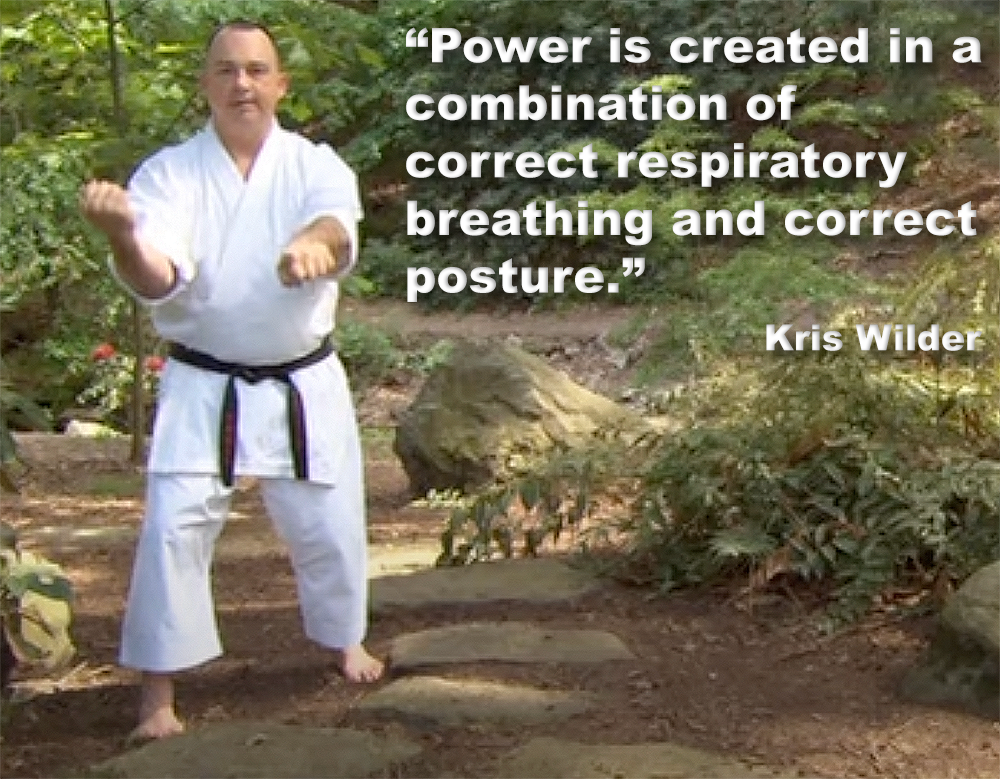
“Power is created in a combination of correct respiratory breathing and correct posture.”
Posted by ADAM CARTER on OCT 19, 2022

“Power is created in a combination of correct respiratory breathing and correct posture.”
In many kata, and indeed the techniques of karate, there should be a great deal of emphasis placed on abdominal breathing. That is, in which you are supposed take very deep, audible, abdominal breaths, synchronized with foot and hand motions.
If we take Sanchin kata as an example, many students I have witnessed practicing this kata, become fairly adept at making a lot of noise when exhaling. However, what should be deep and abdominal, is really thoracic and shallow….. and again, mostly noise.
Many students, and instructors, that I have seen practicing this kata (and many other kata) were not using their “Hara” when the loud exhaled sounds were made; all they are doing is making facial grimaces and, here it is again, a lot of noise, with no connection to their lower abdomen.
Deep “Hara” breathing should be synchronized with your movement.
Hara (腹) is a Japanese word that has no direct equivalent in English. While it literally refers to the lower abdomen, but should not be translated simply as “stomach”. The term also has psychological and spiritual connotations in Japanese language and culture.
In the West we are a society of shallow breathers: afraid of moving our bellies, instead of breathing with the diaphragm people tend to breathe with upper body musculature that is inadequate to the task, with a cascade of musculoskeletal consequences and vulnerabilities.
To stop breathing with your chest and throat muscles, you must have the strength and coordination to breathe well with your diaphragm.
In Sanchin and other similar kata, moderate tension should exist only to hold the pelvis under, keep the abdomen firm (not hard, we don’t want to squeeze it, which can cause breath holding), keep the shoulders pulled down, and a firm hand. Any pushing movements benefit from doing an exhale, as there is resistance to the movement in much the same way as there is resistance to muscles in weight-training.
The proper breathing in Sanchin (and weight-training) should NOT be a Valsalva maneuver (breath hold – or forced expiration against a closed glottis).
As an example, if you are doing a bench press with a heavy weight, IDEAL breathing would involve a restricted exhale. The object is not to use the epiglottis or strain from the throat, as you so often hear. In weight-lifting and karate, the amount of counter-resistance to an exhale should be proportional to the amount of work that one wants to do with a motion.
Sanchin was designed to give us the ability to practice a tremendous dynamic range of resistance motions, and to learn how to correctly measure the breathing resistance. Those I see practice the vein-popping, muscle rippling, throat straining, phlegm inducing, Sanchin, are in my humble opinion, suffering from testosterone induced showmanship. They do impress some people I guess.
IF PROPERLY DONE – Sanchin does not involve isometric (same position) but rather isokinetic (same speed) exercise. One does not do the Valsalva maneuver, but rather slow, measured breath release. It is the exact type of breathing that one should do when weight-training, with the amount of resistance to the breath being proportional to the weight being pushed.
Connection is key. Connection to the breath and the structural movements. The breath doesn’t need to be loud. The breath in Sanchin should support the structural positions when moving and when stationary, it doesn’t have to be a throat straining, loud, forced exhalation.
![]() Photo Credit: Kris Wilder and quote from ymaa.com sanchin kata
Photo Credit: Kris Wilder and quote from ymaa.com sanchin kata
